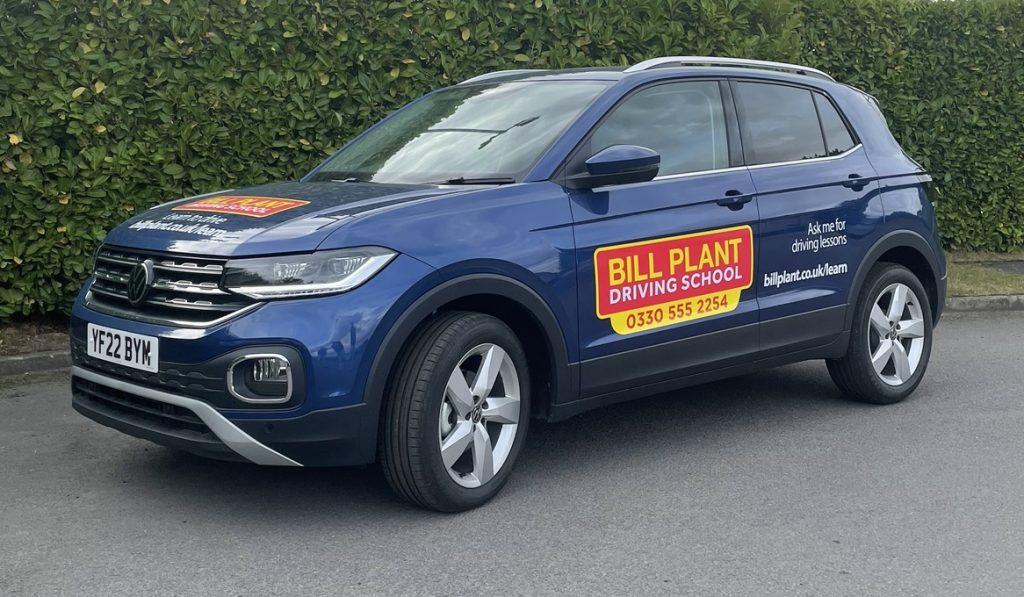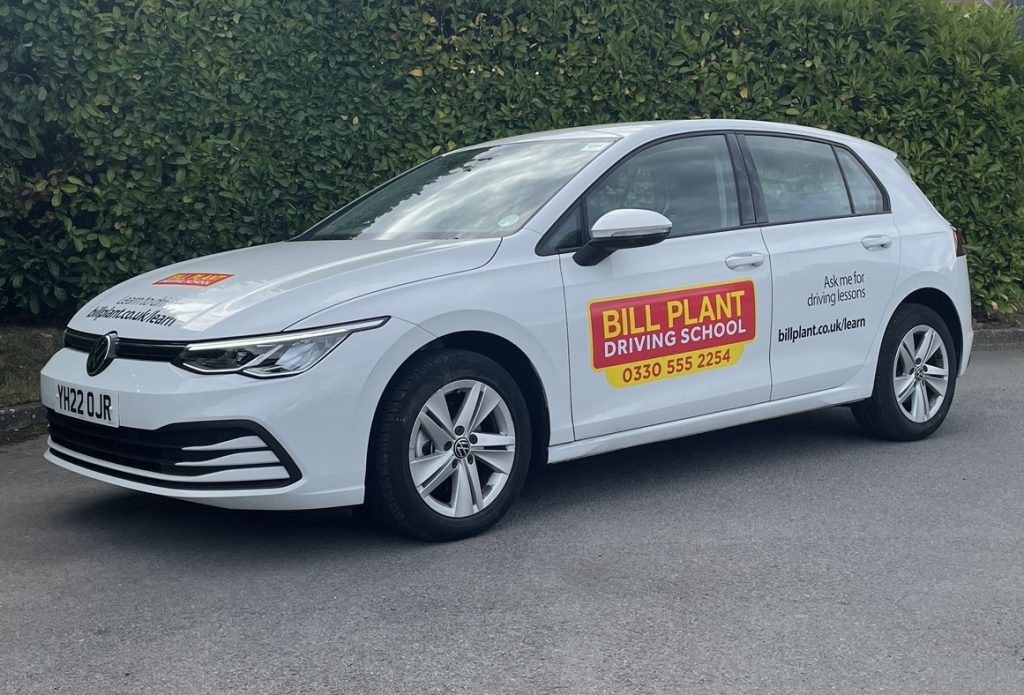Our series on the basics of driving has already covered how to move off and how to set up a car seat. Here at Bill Plant Driving School, we’ve laid out a detailed guide on another essential part of learning to drive.
Meeting oncoming traffic is something you’ll have to deal with frequently, and being taught how to go about it safely will be a fundamental part of your learning experience.
Knowing when to give way, how much space to leave and if you should signal can seem a bit confusing at first. This guide will give you all the tips and advice you’ll need to make these decisions confidently.
We also recommend checking out the basics: car gears, how to adjust your car mirrors, and check out how to understand traffic signs and what they mean.
What does ‘oncoming traffic’ mean?
Oncoming traffic refers to any vehicles that are coming towards you as you’re driving along a road. Traffic can include cars, bikes, motorcycles, lorries, buses and any other vehicles that you may encounter whilst you’re going around.
How to meet oncoming traffic: step-by-step
1. Identify and assess oncoming traffic
If you’re driving and notice an obstruction approaching, you need to start preparing early. Look ahead and see if any traffic is coming towards you on the other side of the road. You then need to determine if you have priority, if the oncoming vehicle does or neither road user has priority.
You should first assess whether there is a safe gap to go into, and gauge how much room there is for you and the oncoming vehicle and how fast you think they’re moving. Based on their speed and the available gap, you should go ahead if you’re sure it’s safe. If you have any doubts, or if neither car has priority, it is often best to wait in what’s called the ‘hold back position’ to ensure the safest approach.
If you have to stop, stay two car lengths back just left of the centre of the road from the obstruction. This will give you a better field of vision to assess the situation and mean you have plenty of space to steer into the road once you move off.
2. Check mirrors
Now that you’ve assessed the situation on the road ahead of you, you’ll need to check what’s behind you. Use your mirrors and check your blind spots, including over both shoulders to make effective all around observations.
This enables you to understand the position of other road users, such as whether another car is tailgating you or if a motorcyclist or cyclist is trying to overtake you. If you don’t think it’s safe to move, you just need to be patient and wait until it is. Taking your time when meeting oncoming traffic is very important.
If you’ve had to wait, then once it’s safe to move off, you’ll need to check the road in front of you once again, as the situation may have now changed.
3. Signal (if needed)
When meeting oncoming traffic, the other drivers will be aware of the obstruction on the road and will be expecting you to steer around it. So, using your indicators in this situation isn’t necessary in most cases.
Your signal could confuse other road users, as they might think you’re planning to turn into a driveway, another road or park your vehicle. This could lead to them pulling out into the road with you simultaneously and may potentially cause a collision. Signals should inform, but not confuse.
4. Move off
You will now be ready to make your move. If you’re stationary, go into first gear and slowly begin to proceed. If you’ve had to slow down, but haven’t come to a complete stop, then still move slowly and make sure you’re in low gear – second gear may be suitable.
Steer to the right and move around the obstruction into the other lane leaving adequate clearance. As you do this, remain aware of what’s around you. There could be a vehicle unexpectedly pulling out of a side road ahead or somebody trying to overtake you from behind.
Once you’re clear of the obstruction, check your left-hand mirror, and safely move back into your lane.
Yielding to oncoming traffic
Giving way to oncoming traffic is when an oncoming vehicle has priority on the road, so you have to let them pass. The safest way to do this is to remain in the hold back position, as we mentioned before.
This will let the oncoming vehicle know that you are yielding to them rather than simply pulling over to the side of the road to park. It also means that you will have a better view of the road ahead for when you start to move.
As we mentioned, sometimes, you may be unsure of who has priority or if the other oncoming vehicle is moving too quickly for you to be able to go. It is safest to yield to the oncoming traffic in these situations rather than proceeding when you’re unsure in almost every situation.
Who has the right of way?
Determining who has the right of way, more commonly known as priority, when meeting oncoming traffic is vital, so you must be familiar with the different situations you could encounter while on the roads.
- An obstruction on the other side of the road:
If there is an obstruction on the opposite side of the road from you, then any vehicles coming in the other direction should be stopping and allowing you to pass them, as you have the right of way. Some drivers will still try and take priority, even if it’s not their right of way, so always be prepared to take evasive action if necessary. - An obstruction on your side of the road:
If the obstruction is on your side of the road and the other side is clear, you will need to stop and allow any oncoming traffic to pass, as they have the right of way. Make sure you leave enough room to let them pass safely. - Obstructions on both sides of the road:
On narrow roads or roads where there are obstructions on both sides, neither vehicle has priority. It’s up to either driver to decide who will go first. If you realise that the other vehicle is going faster than you are and will reach the gap in the road before you do, you should yield to them and allow them to pass. If you’re sure you will reach the gap before the other driver, proceed yourself, but with caution. If the other driver flashes their lights at you, they may be signalling that they have given you the priority to proceed, but this cannot be guaranteed. You need to be very careful when you move off as there could be a motorcyclist or a cyclist about to overtake them.
Our training on the hazard perception test and changes to the highway code in 2022 will ensure you are well informed and updated with everything driving-related.
Passing parked vehicles
The most common obstacles you will have to deal with when driving are parked cars. When passing parked vehicles, you should follow the same steps we’ve laid out to any obstruction you encounter.
But, when passing parked vehicles specifically, you need to make sure that you leave a gap that is the width of an open, average car door where possible and reducing your speed if the gap is less than this. This means you’re prepared for a car door opening and gives you more time to react if a pedestrian steps out into the road from behind the parked cars.
If you’re travelling along a road that has rows of parked vehicles on it, make sure you keep a lookout for places in the road where there are gaps. Then, if you encounter any oncoming traffic in the middle of the road, you will know where there is a place that you can safely pull into.
Top tips for meeting oncoming traffic
- Wide roads: on some wider roads, there may be enough space for both vehicles to pass freely, without anyone giving way. Just make sure you leave a big enough gap so that the oncoming car can pass safely by.
- Passing parked vehicles: always leave a big enough gap that an average car door could open safely as you drive past. Then, you’re protected from a car door suddenly opening or a pedestrian walking out into the road.
- Be careful with the right of way: don’t assume that oncoming vehicles will give you priority, even if you know you have the right of way. Some other drivers will still attempt to proceed when they shouldn’t.
- Mirrors and blind spots: always be aware of what’s behind you and what’s in front of you.
Oncoming traffic: main takeaways
Meeting oncoming traffic is something that you’ll deal with regularly when you’re out on the roads, and you must know the safest ways to deal with each possible situation.
The main thing to remember is to stay calm and take your time to assess who has priority before taking action. This is something that your instructor will focus on with you during your driving lessons.At Bill Plant Driving School, we help you get to grips with the basics as you learn to drive and ensure you’re confident and ready for all the situations you’re likely to encounter.

